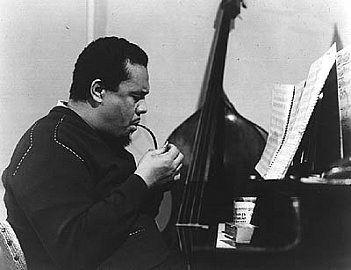The Charlie Mingus Jazz Workshop – Pithecanthropus Erectus
Released: 1956
Label: Atlantic
This early Atlantic session in 1955 was one of the first of the bassist-composer’s workshop-style programmes. He felt that written music could not convey the true music of the composer, as musicians would put their own invention on it. His method was to play each individual part to each musician on piano so that they fully understood the composer’s intention and would play it the way he “heard” it.

The title song was described by Mingus as a ten-minute tone poem, depicting the rise of man from his hominid roots (Pithecanthropus erectus) to an eventual downfall. A section of the piece was free improvisation, free of structure or theme.
I know that to many, Jazz is sometimes just noise, but these recordings bridge the gap in some ways. There are random noises within the compositions, but there is always a melody, and Mingus tends to stick to chord structures.
Tracklist
Pithecanthropus Erectus
A Foggy Day
Profile Of Jackie
Love Chant
Here are ten interesting facts about this groundbreaking album:
- Concept Album Before Its Time – Pithecanthropus Erectus is considered one of the first jazz concept albums. Mingus envisioned it as a musical depiction of early man’s rise and fall, making it a narrative-driven work.
- Title Meaning – The album’s title refers to Homo erectus, an early human ancestor. Mingus used it as a metaphor for humanity’s progression and eventual self-destruction due to greed and arrogance.
- Revolutionary Approach to Composition – Unlike traditional jazz arrangements, Mingus gave his musicians loosely structured frameworks and encouraged them to improvise freely, pioneering a more collective approach to jazz.
- First Major Critical Success – The album was a turning point in Mingus’s career, establishing him as a leading force in avant-garde and post-bop jazz.
- Four-Track Structure – The album consists of four compositions:
- Pithecanthropus Erectus – The 10-minute title track, telling a story of humanity’s rise and fall.
- A Foggy Day (In San Francisco) – A reworking of the Gershwin classic with an eerie, impressionistic feel.
- Profile of Jackie – A tribute to saxophonist Jackie McLean.
- Love Chant – A hypnotic, extended improvisation piece.
- Innovative Use of Collective Improvisation – The title track features overlapping, chaotic horn sections that reflect a freer approach to jazz, influencing future avant-garde musicians.
- Political and Social Undertones – Mingus was known for embedding political and racial themes in his music. Pithecanthropus Erectus metaphorically critiques the hubris of modern civilization, a theme he would explore throughout his career.
- Experimental Soundscapes – Mingus pushed the limits of traditional jazz harmonies, incorporating dissonance, bluesy phrasing, and unstructured moments, foreshadowing the free jazz movement.
- Strong Saxophone Presence – The album features Jackie McLean (alto sax) and J.R. Monterose (tenor sax), who brought a raw, expressive edge to Mingus’s compositions.
- Lasting Influence – The album paved the way for the development of free jazz, modal jazz, and jazz fusion, with its emphasis on spontaneity and musical storytelling. Many jazz innovators, including John Coltrane and Ornette Coleman, drew inspiration from Mingus’s bold approach.


Leave a Reply